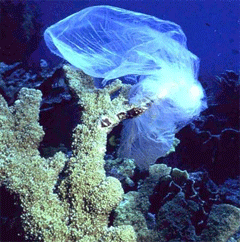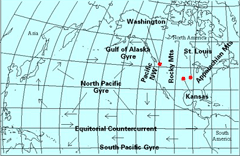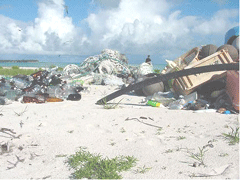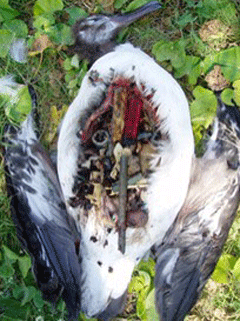Plastic, Plastic Everywhere
Air Date: Week of June 29, 2007

That’s not a jellyfish. It’s a plastic bag, the type that turtles often mistake for food. (Courtesy of NOAA)
Captain Charles Moore is one of a growing number of researchers who are alarmed at how much plastic is littering our oceans. Moore tells Living on Earth’s Ingrid Lobet that he’s not only concerned about large pieces of plastic; it’s the microscopic bits that are problematic, as well.
Transcript
CURWOOD: A decade or so ago Charles Moore veered off course in a sailing race from California to Hawaii and found himself in a windless area called the North Pacific Gyre. Nearly everywhere he looked was floating plastic. In fact, so much plastic has accumulated there that it covers an area more than twice the size of Texas. The encounter inspired Captain Moore to found the Algalita Marine Research Foundation to study the effects of plastic on the ocean. He says it’s the large pieces of plastic trash that have gotten the most attention, but he’s increasingly concerned about the smaller stuff that’s not so obvious. Captain Moore recently spoke with Living on Earth’s Ingrid Lobet.
LOBET: Captain Moore, we’ve all heard about plastic trash winding up in the ocean, but now it turns out that if a scientist scoops up a handful of sand or seawater just about anywhere and looks through a microscope he or she actually sees plastic. How can that be?

Map of the North Pacific Gyre, a region of the Pacific where multiple currents come together and trap garbage that blows off land. (Courtesy of USGS.)
MOORE: Plastic does not biodegrade. It’s what we call bio-inert. So what happens is plastic becomes enbrittled, it ages through a series of processes instigated by ultraviolet light from the sun. And that degradation results in cracking and weakening of the tensile strength of the plastic, but it doesn’t result it its becoming carbon dioxide and water like a piece of wood would or a piece of food scrap.
LOBET: But the amount, we’ve actually changed the composition to the degree that any random sample that you look at under the microscope is now no longer mostly natural material?
MOORE: As a matter of fact, in coastal studies off Southern California and in studies as far from the coast as you can get, half way between Los Angeles and Hawaii, we found that in the surface, plastic outweighs plankton. And the coastal ocean even has more plastic than plankton near the bottom. We’ve done tows with what we call an epibenthic sled that pulls a net just above the floor of the ocean off of Southern California and in those studies as well we found more plastic than plankton.
LOBET: And what is the main pathway? How has this much plastic made its way into the ocean?
MOORE: I think it’s all of us and our product and food delivery system, which is largely plastic. Trash receptacles are not always available. It’s very lightweight and it blows and washes into the sea.

Piles of plastic garbage were collected in one morning on Easter Island. (Photo: B. Mayer/U.S. Fish and Wildlife Service)
MOORE: Well, because the main life cycle, the main activity that goes on in the ocean happens at what we call the base of the marine food web in filter feeding organisms. And if molecular sized bits of plastic are floating around there, they’re going to filter them out. And the fish, and birds, and dolphins, and whales and turtles, these larger creatures are feeding off of creatures, which have consumed this plastic material. So we’re concerned because this plastic material has been demonstrated to act as a sponge for pollutants. And thereby transfer them into this marine food web.

This albatross chick died with 306 pieces of plastic in its belly. Some of them up to 6 inches long and jagged. (Photo: Claire Johnson/NOAA)
LOBET: As far as their appearance do these plastic shards and pieces, do they mimic food for sea animals?
MOORE: I’ve often said that there’s no food in the ocean that plastic can’t mimic. Just as plastic is infinitely moldable, the way it breaks down in the ocean is infinitely variable. We have very large objects of plastic in the ocean and we have very small objects of plastic in the ocean. And they assume virtually every shape, consistency, and color. Actually we think color is a very important component of consumption by creatures that selectively take prey. In birds stomachs we find mostly red bottle caps, red cigarette lighters. Then there’s the issue of what the turtles eat. The turtles each jellyfish, which are pretty transparent and their consistency is fairly watery which a plastic bag can mimic very well. So, they’re easily confused and it’s well known that turtles are eating large quantities of plastic bags.
LOBET: There is this development that researchers are taking about bioplastics, or making plastic-like material from vegetable matter. How much of a solution is that to the problem of plastics in the ocean?

That’s not a jellyfish. It’s a plastic bag, the type that turtles often mistake for food. (Courtesy of NOAA)
LOBET: What should government be doing and what else should individuals be doing?
MOORE: Well, government has to what I refer to as kick start the infrastructure. We have to have take back programs. I mean 27 percent of the total of what we found out in the North Pacific Gyre was thin plastic films like is used in packaging. That material has virtually no take back. No code has to be printed on it so that you know what kind it is. And there’s no infrastructure for taking it back and reusing it. Individuals need to bring their own bag, they need to bring their own cup. They need to make choices about the products that they buy and look for things that aren’t wrapped in plastic. I consider to be an irony that a product that lasts forever is used for seconds and tossed.
LOBET: Well, thanks so much for talking with us.
MOORE: You’re welcome. Thank you for the interview.
[Fridge "Insects" from ‘The Sun’ (Temporary Residence -2007)]
CURWOOD: Captain Charles Moore of the Algalita Marine Research Foundation, speaking with Living on Earth’s Ingrid Lobet.
Links
Living on Earth wants to hear from you!
Living on Earth
62 Calef Highway, Suite 212
Lee, NH 03861
Telephone: 617-287-4121
E-mail: comments@loe.org
Newsletter [Click here]
Donate to Living on Earth!
Living on Earth is an independent media program and relies entirely on contributions from listeners and institutions supporting public service. Please donate now to preserve an independent environmental voice.
NewsletterLiving on Earth offers a weekly delivery of the show's rundown to your mailbox. Sign up for our newsletter today!
 Sailors For The Sea: Be the change you want to sea.
Sailors For The Sea: Be the change you want to sea.
 The Grantham Foundation for the Protection of the Environment: Committed to protecting and improving the health of the global environment.
The Grantham Foundation for the Protection of the Environment: Committed to protecting and improving the health of the global environment.
 Contribute to Living on Earth and receive, as our gift to you, an archival print of one of Mark Seth Lender's extraordinary wildlife photographs. Follow the link to see Mark's current collection of photographs.
Contribute to Living on Earth and receive, as our gift to you, an archival print of one of Mark Seth Lender's extraordinary wildlife photographs. Follow the link to see Mark's current collection of photographs.
 Buy a signed copy of Mark Seth Lender's book Smeagull the Seagull & support Living on Earth
Buy a signed copy of Mark Seth Lender's book Smeagull the Seagull & support Living on Earth

